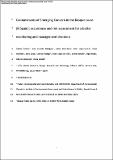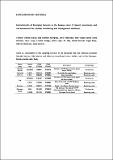Por favor, use este identificador para citar o enlazar a este item:
http://hdl.handle.net/10261/223102COMPARTIR / EXPORTAR:
 SHARE SHARE
 CORE
BASE CORE
BASE
|
|
| Visualizar otros formatos: MARC | Dublin Core | RDF | ORE | MODS | METS | DIDL | DATACITE | |

| Título: | Contaminants of emerging concern in the Basque coast (N Spain): Occurrence and risk assessment for a better monitoring and management decisions |
Autor: | Solaun, Oihana; Rodríguez, José Germán; Menchaca, Iratxe; López-García, Ester CSIC; Martínez, Elena CSIC ORCID ; Zonja, Bozo CSIC ORCID; Postigo, Cristina CSIC ORCID ; López de Alda, Miren CSIC ORCID ; Barceló, Damià CSIC ORCID; Borja, Ángel; Manzanos, Alberto; Larreta, Joana | Palabras clave: | Wastewater EU watch list Water Framework Directive Priority substances directive Receiving water |
Fecha de publicación: | 5-oct-2020 | Editor: | Elsevier | Citación: | Science of the Total Environment 142765 (2020) | Resumen: | The study of the presence in the aquatic environment of certain substances considered as contaminants of emerging concern (CEC) is a preliminary step to the analysis of the possible harmful effects on aquatic ecosystems and the establishment of the corresponding environmental quality standards. In order to monitor the occurrence of CECs in the aquatic environment, the European Commission established in 2015 and 2018 two watch-list of substances for Union-wide monitoring in the field of water policy (Decision (EU) 2015/495 and Decision (EU) 2018/840). In the coast of the Basque Country, southeast of the Bay of Biscay, 19 of these watch list substances were monitored quarterly from May 2017 to March 2019. Water samples were collected at the effluent of three wastewater treatment plants and five control points associated with receiving waters (transitional and coastal water bodies). The most frequently quantified substances were azithromycin (91%), imidacloprid (82%), clarithromycin (80%), diclofenac (78%) and erythromycin (73%), with frequencies of quantification higher in wastewaters (83–100%) than in receiving waters (70–85%). In general, concentrations in wastewater were also higher than in receiving waters, indicating a dilution effect in the environment. In receiving waters, six out of the nineteen substances monitored exceeded their respective Predicted No-Effect Concentrations: azithromycin (34%), imidacloprid (9%), 17β-estradiol (E2) (9%), clarithromycin (7%), ciprofloxacin (7%), and diclofenac (5%); and therefore, their levels could pose an environmental risk. | Versión del editor: | https://doi.org/10.1016/j.scitotenv.2020.142765 | URI: | http://hdl.handle.net/10261/223102 | DOI: | 10.1016/j.scitotenv.2020.142765 |
| Aparece en las colecciones: | (IDAEA) Artículos |
Ficheros en este ítem:
| Fichero | Descripción | Tamaño | Formato | |
|---|---|---|---|---|
| emergentes_pais vasco_repositorio.pdf | Artículo principal | 1,42 MB | Adobe PDF |  Visualizar/Abrir |
| SupplementaryMaterial_STOTEN-D-20-15682_repositorio.pdf | Material suplementario | 2,69 MB | Adobe PDF |  Visualizar/Abrir |
CORE Recommender
SCOPUSTM
Citations
27
checked on 20-abr-2024
WEB OF SCIENCETM
Citations
24
checked on 25-feb-2024
Page view(s)
117
checked on 22-abr-2024
Download(s)
221
checked on 22-abr-2024
Google ScholarTM
Check
Altmetric
Altmetric
NOTA: Los ítems de Digital.CSIC están protegidos por copyright, con todos los derechos reservados, a menos que se indique lo contrario.
